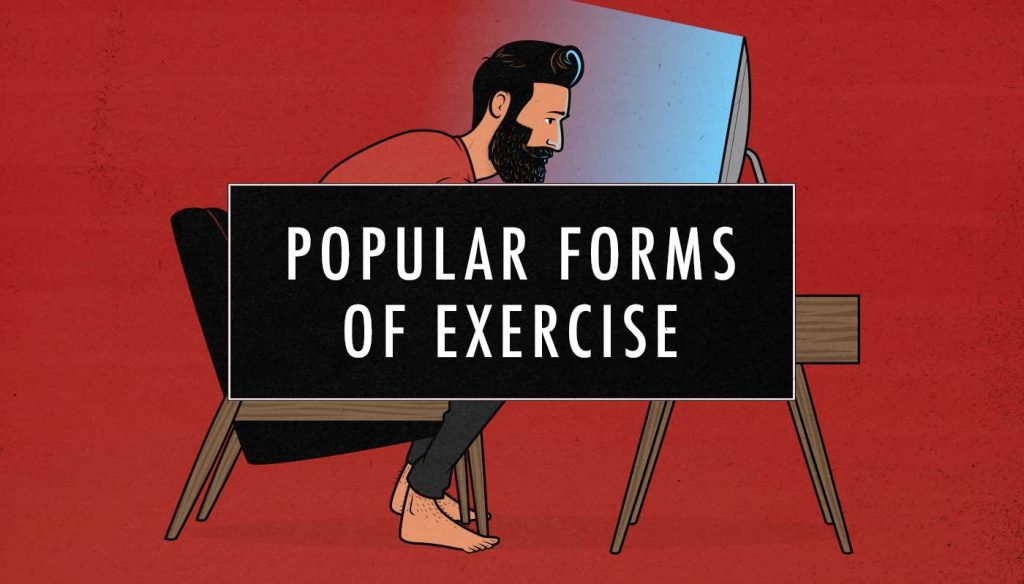
The Most Popular Forms of Exercise (According to Google)
What type of exercise is the most popular? Then, when it comes to lifting weights, which type of weight training is the most popular? Is bodybuilding more popular than CrossFit? Is CrossFit more popular than powerlifting?
Another thing I was curious about is whether more people were interested in training at home or at the gym. And for people training at home, are they more interested in using a barbell, dumbbells, resistance bands, or doing calisthenics?
To answer all of these questions, we can look at Google Trends to see what information people are looking for online.

Bodybuilding
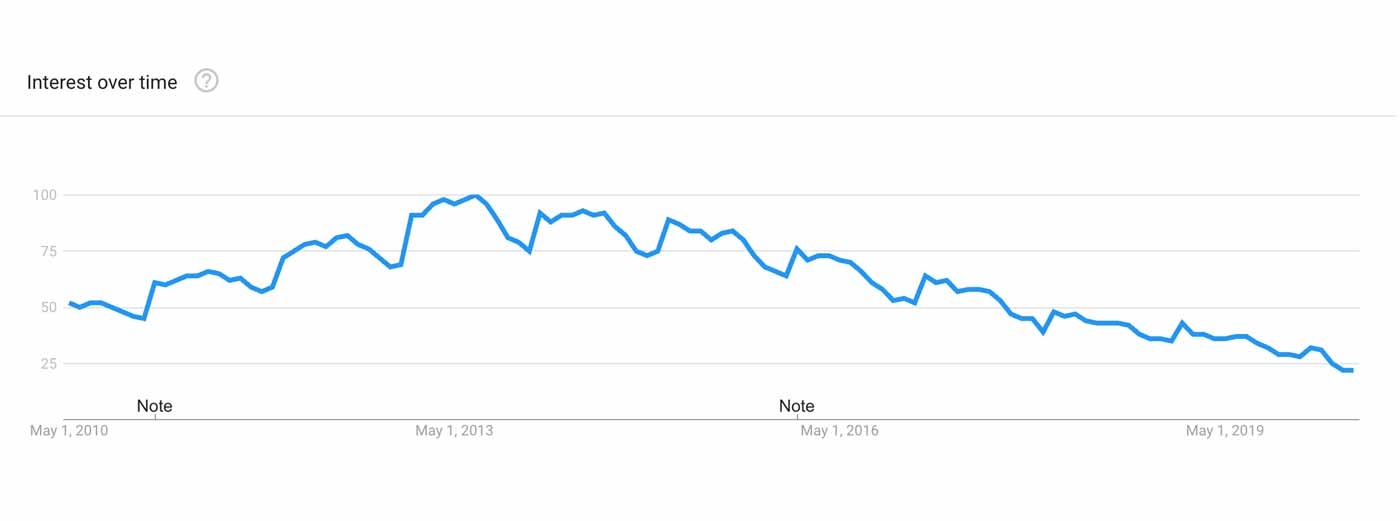
Bodybuilding peaked in popularity in July 2013 and then started a gradual decline, which is interesting. I wonder why it’s declining in popularity. What are people who want to gain muscle size and improve their aesthetics searching for instead? Or is there a shift away from training for size and aesthetics? (I doubt that.)
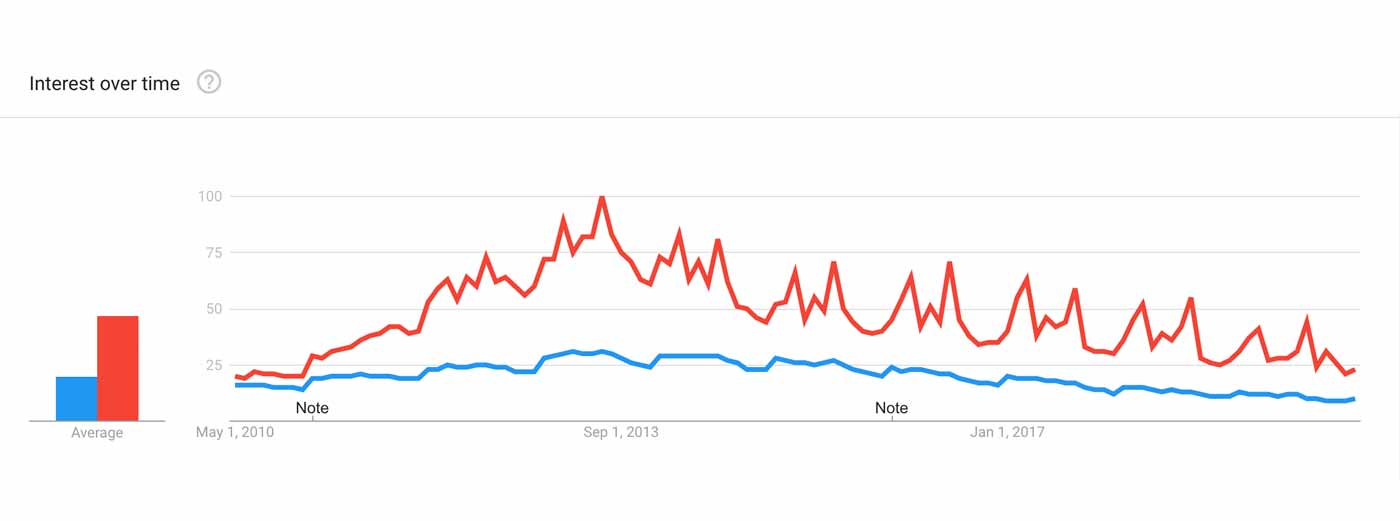
I thought it might be another style of training, such as CrossFit, that was gaining polarity instead, but that doesn’t seem to be the case. CrossFit is massively, massively popular, but it peaked at a similar time to bodybuilding and has been declining since then. So again, what are people looking for instead?
The other thing to consider is that gaining muscle and strength is crucial for our general health, and a recent study 70% of the American population doesn’t have enough muscle mass or strength to be healthy. Now, it’s not that we need to do bodybuilding, per se—strength training or CrossFit would be fine, too—but it would be worrying if all forms of resistance exercise were waning in popularity.
Hypertrophy Training
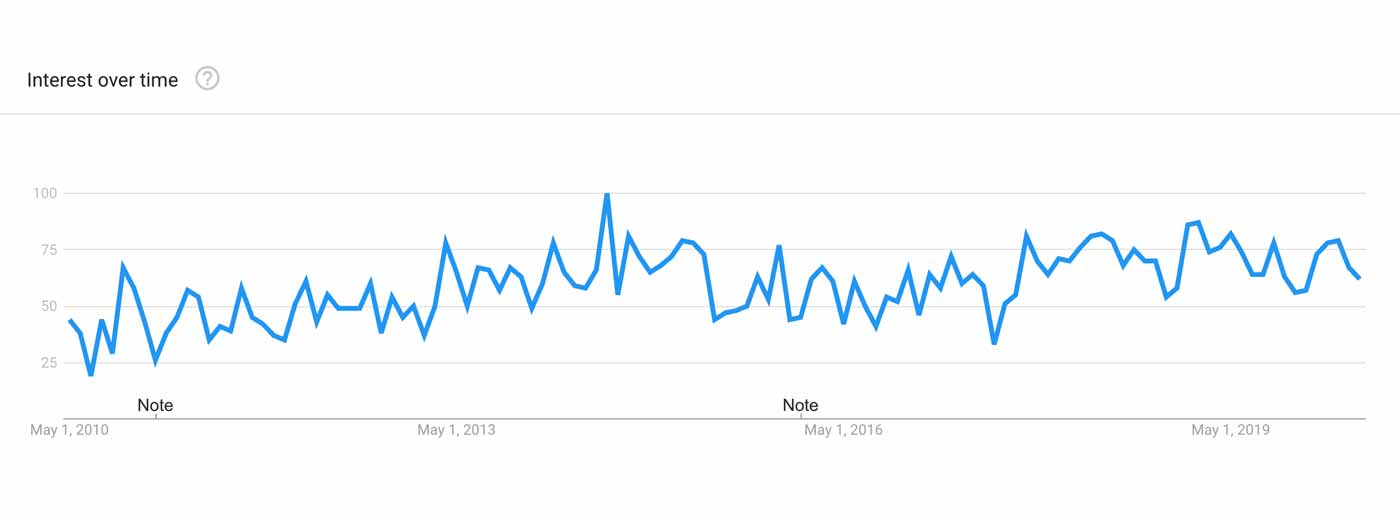
Next up is my favourite style of training, hypertrophy training, it looks like its popularity has ever-so-slightly improved over the past ten years. However, unfortunately, it’s not a very popular term.
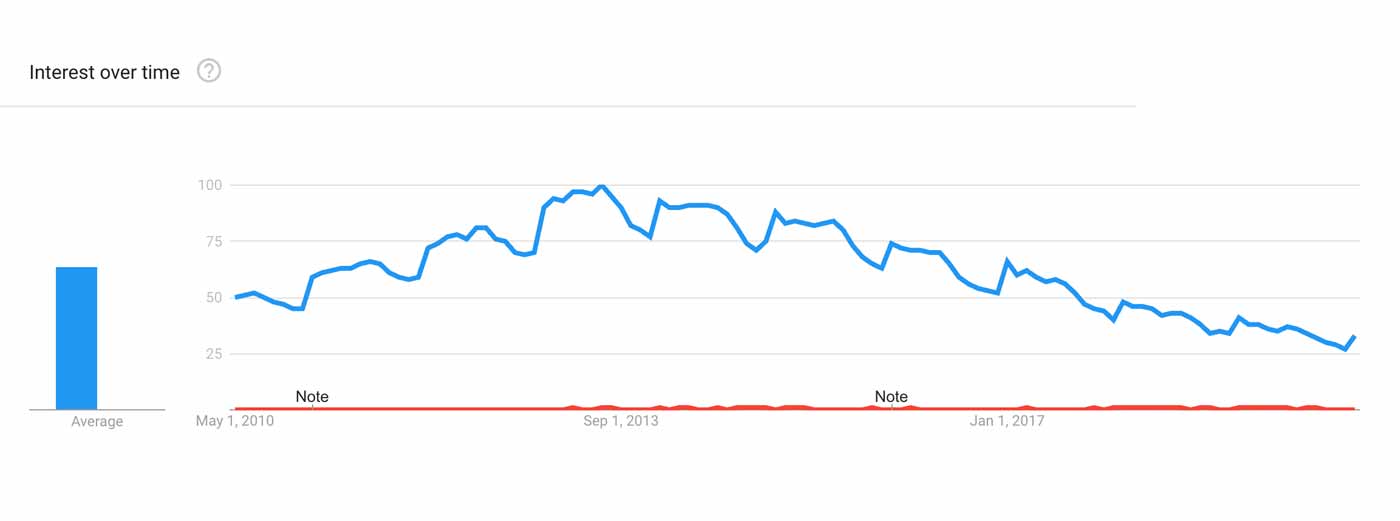
If we compare bodybuilding (blue) against hypertrophy training (red), it’s clear that bodybuilding is still the main term being used for gaining muscle size and aesthetics. And that’s fine. But the reason I like “hypertrophy training” is because it doesn’t get bogged down with all the other meanings and connotations of bodybuilding.
Quite simply, hypertrophy training simply means: training to gain muscle size. It doesn’t have anything to do with competing on stage in a thong, spray tanning, dieting down to ultra-low body fat percentages, or training in a way that bodybuilding judges prefer.
To be clear, when most people say “bodybuilding,” they just mean training to build bigger and stronger muscles. Thing is, there are all of these little accidental nuances that can get mixed in, and that can get confusing.
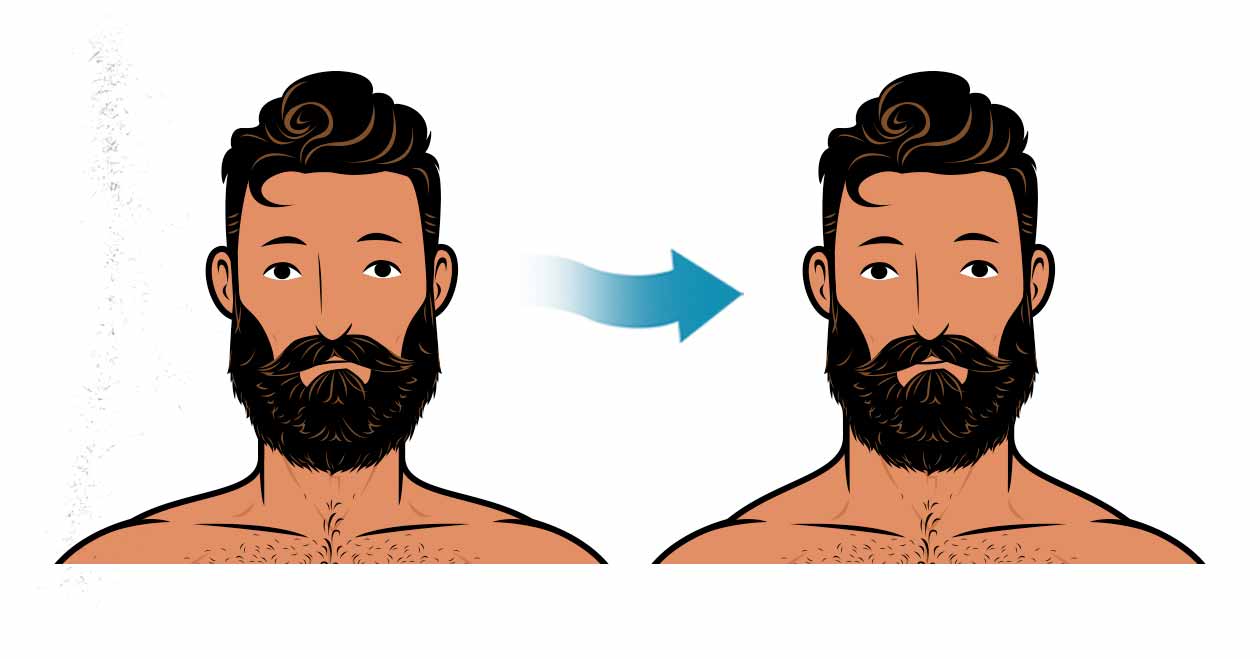
For instance, to improve our overall attractiveness (at least for men), one of the most important things we can do is bulk up our necks. Same thing we wanted to build a tougher, stronger, and more athletic physique. Having a bigger neck would help us avoid concussions, knockouts, and brain trauma. But in bodybuilding, neck training isn’t factored into judging, and so neck training isn’t a part of bodybuilding culture or training.
For another example, you’ll see a lot of people criticizing “bodybuilding” for various reasons: too many exercise machines, too many isolation lifts, not enough barbell work, not enough compound lifts, not enough squatting and deadlifting. Or, worse, they’ll assume that bodybuilders are big but weak. It’s all nonsense, of course—bigger muscles are stronger muscles, and bodybuilding can have a foundation of big compound lifts. But even so, “bodybuilding” has a lot of baggage.
The Most Popular Bodybuilding Programs
To find the most popular bodybuilding programs, I tried plugging in all of the ones that are commonly mentioned around the internet, as well as the ones that we hear about the most. The three most popular bodybuilding routines seem to be Jeff Cavaliere’s Athlean-X, Gregory O’Gallagher’s Kinobody, Mike Matthews’ Bigger, Leaner, Stronger, and the Reddit phenomenon, nSuns.

Of these routines, it seems like Athlean-X is currently around 6.5x more popular than Kinobody, and then Bigger, Leaner, Stronger and nSuns are only around a quarter as popular as Kinobody. All of these brands and programs are incredibly popular, though.
What’s interesting is that, like us, none of these brands want to be associated with all the baggage that the term “bodybuilding” comes along with. Athlean-X is all about training like an athlete who’s rehabbing injuries, Kinobody promises a Hollywood physique, nSuns is rooted in 5/3/1 strength training, and Bigger, Leaner, Stronger is a sort of push/pull/legs split routine that’s marketed as being a strength training program for people who want to improve their appearance.
I tried putting in more evidence-based bodybuilding sources, such as Dr Brad Schoenfeld (the main hypertrophy researcher), Greg Nuckols (Stronger by Science), James Krieger (Weightology), Mike Israetel (Renaissance Periodization), and Jeff Nippard (an evidence-based natural bodybuilder), but they didn’t rank alongside mainstream behemoths like Jeff Cavaliere and Gregory O’Gallagher.
Strength Training
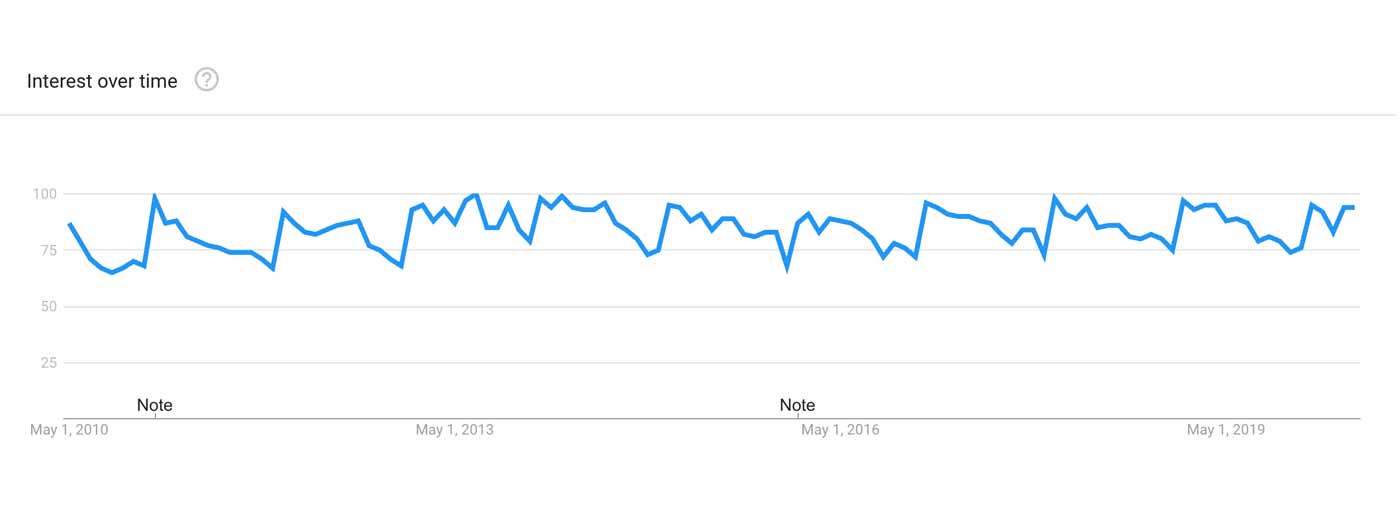
It looks like the popularity of the term “strength training” has been fairly consistent for the past ten years. We’re seeing seasonal fluctuations every year, but it always has similar peaks and valleys. Interesting. Makes me wonder which strength training programs are the most popular right now.

However, when we compare strength training against bodybuilding, it’s only about a third as popular. People are still far more interested in gaining muscle size than they are in gaining muscle strength, at least in terms of what they’re searching for.
The Most Popular Strength Training Programs
To find the most popular strength training programs, I tried plugging in all of the ones that are commonly mentioned around the internet, as well as the ones that we hear about the most. The three most popular routines seem to be Mark Rippetoe’s Starting Strength, Mehdi’s StrongLifts 5×5, and Jim Wendler’s 5/3/1 program.

If we compare the three programs over the past ten years, it seems like Starting Strength has always been the most popular strength training program. StrongLifts 5×5 briefly passed it in 2014 but has since fallen down to about half of Starting Strength’s popularity. That’s not surprising, given that Mehdi seems to have stopped coming out with new content.
Jim Wendler’s 5/3/1 program has been immensely popular this entire time, especially among the crew who consider themselves a bit more hardcore. There are other hardcore strength training routines such as Smolov that are incredibly popular, but 5/3/1 is far more popular still.
What’s really interesting about these programs is that they’re much more popular than the most popular bodybuilding programs. Bodybuilding and gaining muscle size are far more popular than strength training, but the bodybuilding programs are far less popular than the strength training programs. It makes me wonder if people don’t realize that strength training isn’t very good for gaining muscle size.
One final thing I’ll note here is that although it seems that these programs were at their peak popularity in 2012–2013, that’s not necessarily the case. What we’re looking at here are branded queries, where people are specifically typing in the brand name. With our own Bony to Beastly and Bony to Bombshell sites, they show that same surge around 2012–2013. But we have more traffic now than ever before, largely because our traffic has increased from unbranded queries—from people searching about how to gain weight or bulk instead of searching “Bony to Beastly.” This brings in more overall traffic and new readers.
I almost wonder if what we’re seeing is that people used to find their favourite sites by searching for them, whereas now they find their favourite sites by going directly to them.
Powerlifting
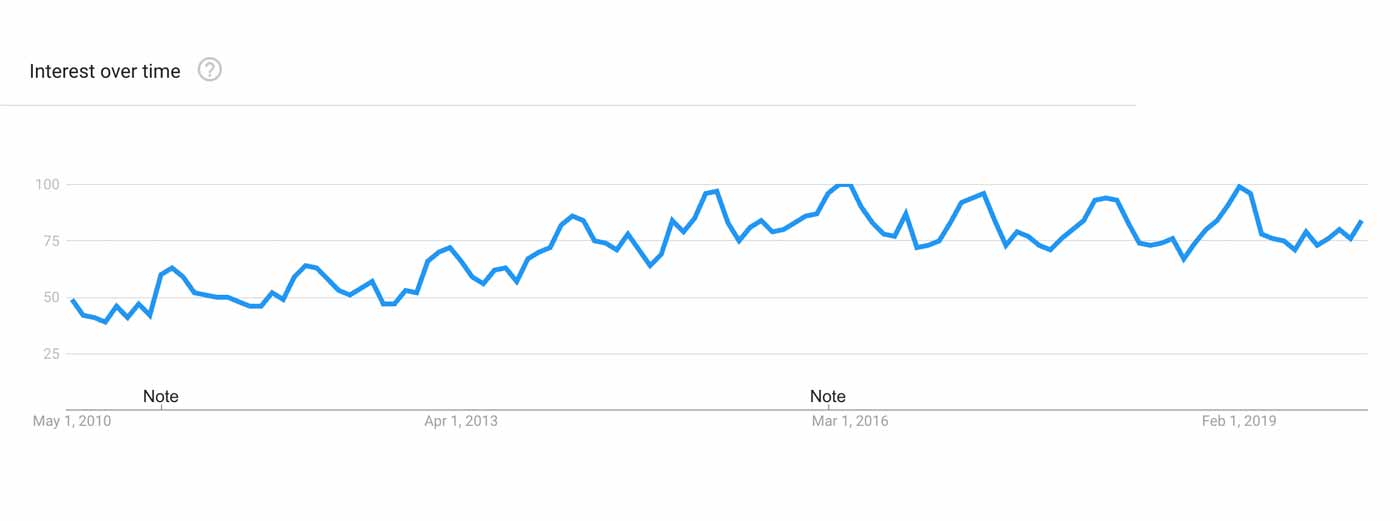
Powerlifting has been steadily gaining in popularity for the past ten years. However, it’s still a relatively small term. It certainly doesn’t explain the falling popularity of bodybuilding.
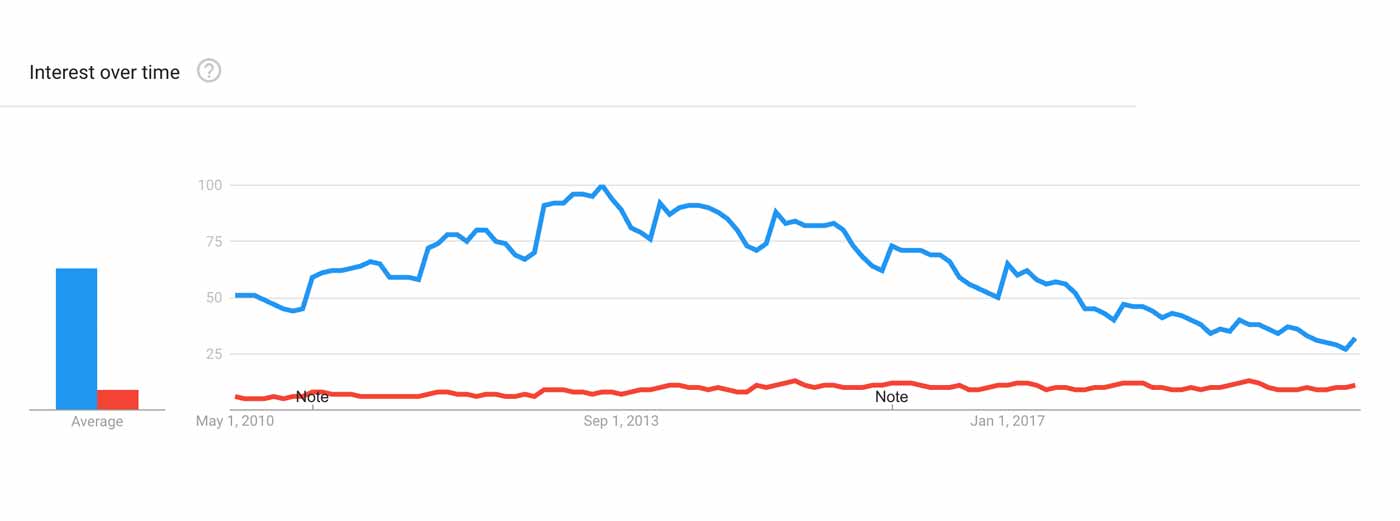
This gets especially interesting when we compare powerlifting (red) against the falling popularity of bodybuilding (blue). But even with bodybuilding’s falling popularity, it’s still three times as popular as powerlifting.
Olympic Weightlifting & Strongman
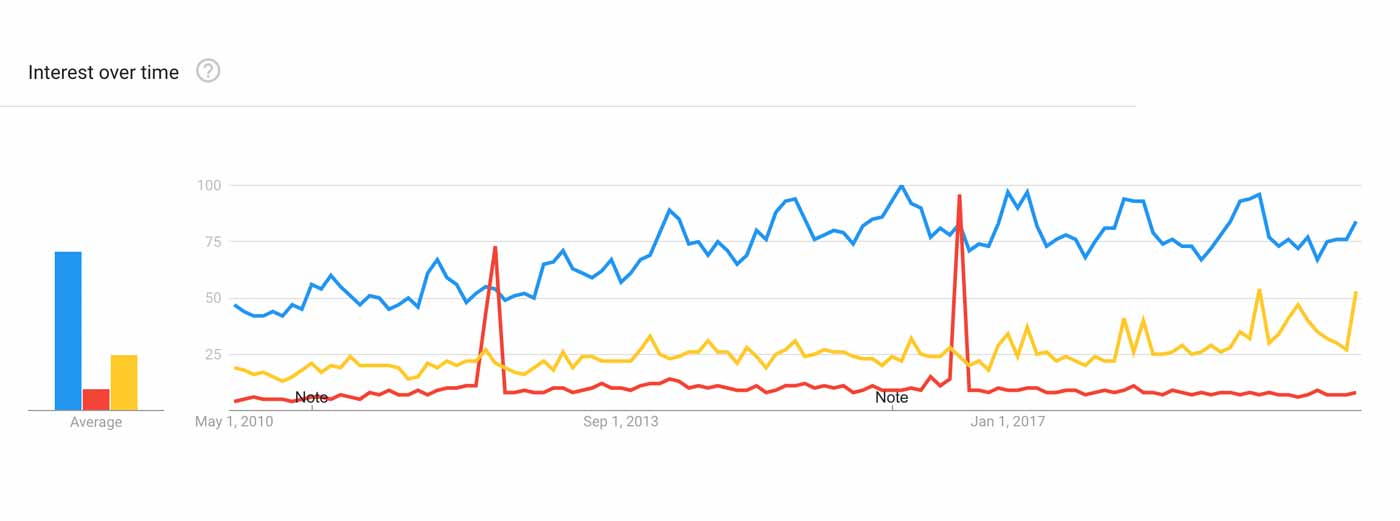
If we look at the other two strength sports, Olympic weightlifting and strongman, we see that powerlifting is by far the most popular strength sport (although Olympic weightlifting surges in popularity during the Olympics, of course). Powerlifting is nearly three times as popular as strongman training, and nearly ten times as popular as Olympic weightlifting.
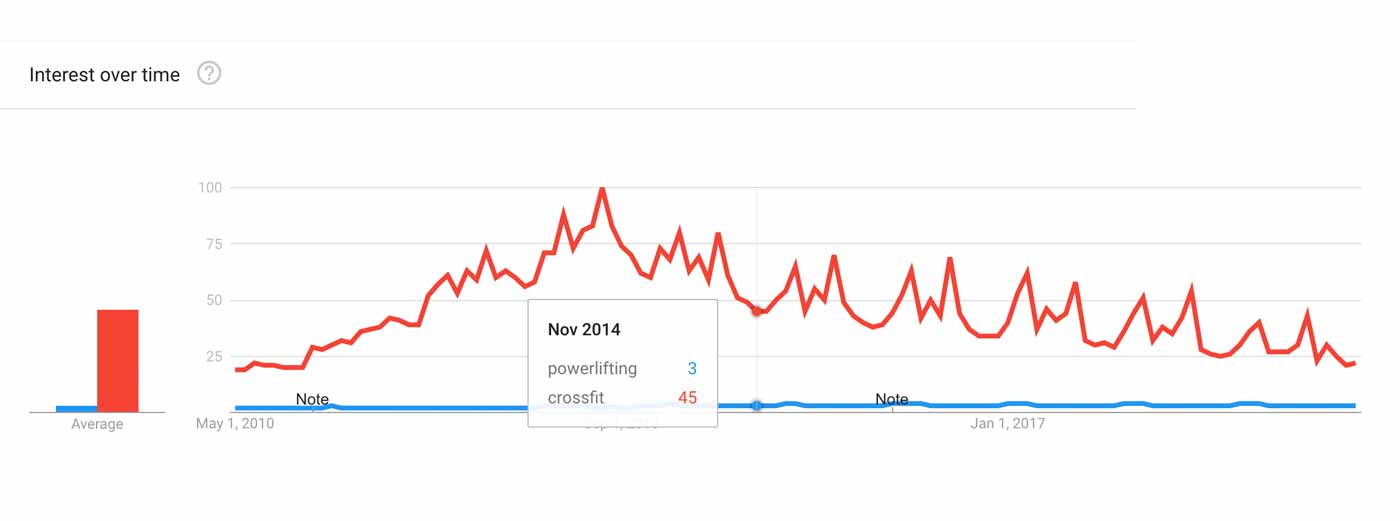
Although, I suppose, if you consider CrossFit to be a competitive strength sport, and if you consider that it involves Olympic weightlifting lifts, then it’s much more popular than powerlifting.
Powerbuilding
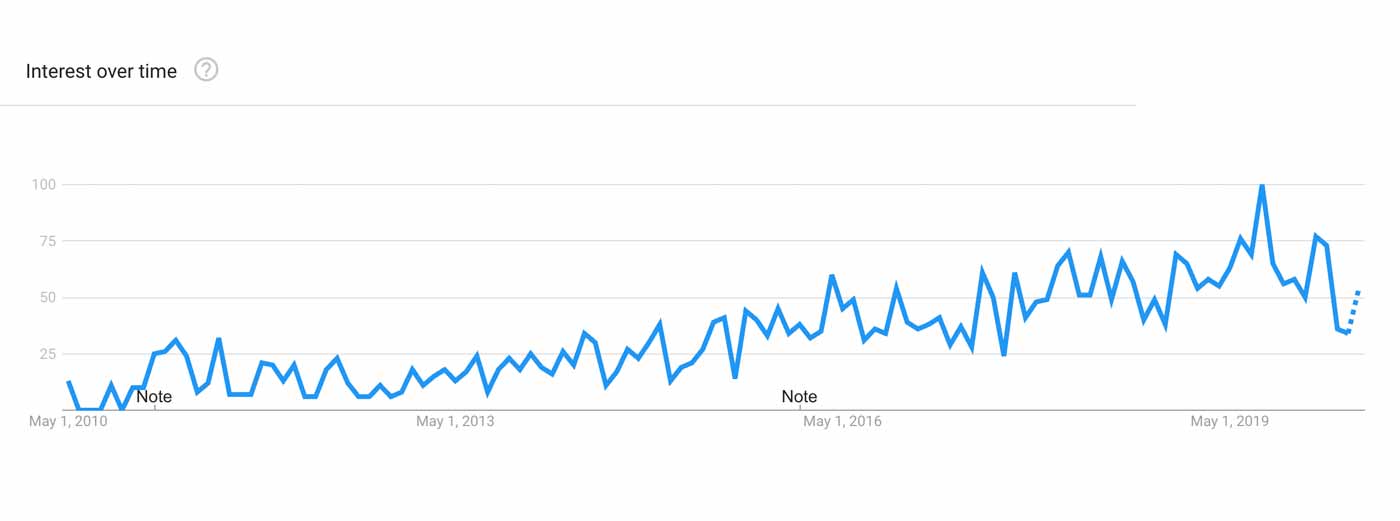
Powerbuilding is the combination of both powerlifting training and bodybuilding training. There’s a huge emphasis on improving 1-rep-max (1RM) strength on the squat, bench press, and deadlift, but there’s also a ton of accessory work thrown in for the purposes of gaining overall muscle size and aesthetics.
It’s a neat idea, given that many powerlifters want to look muscular and many bodybuilders want impressive 1RMS on the big lifts. And so powerbuilding was steadily gaining popularity up until last year, at which point it has started to fall. What’s going on there?
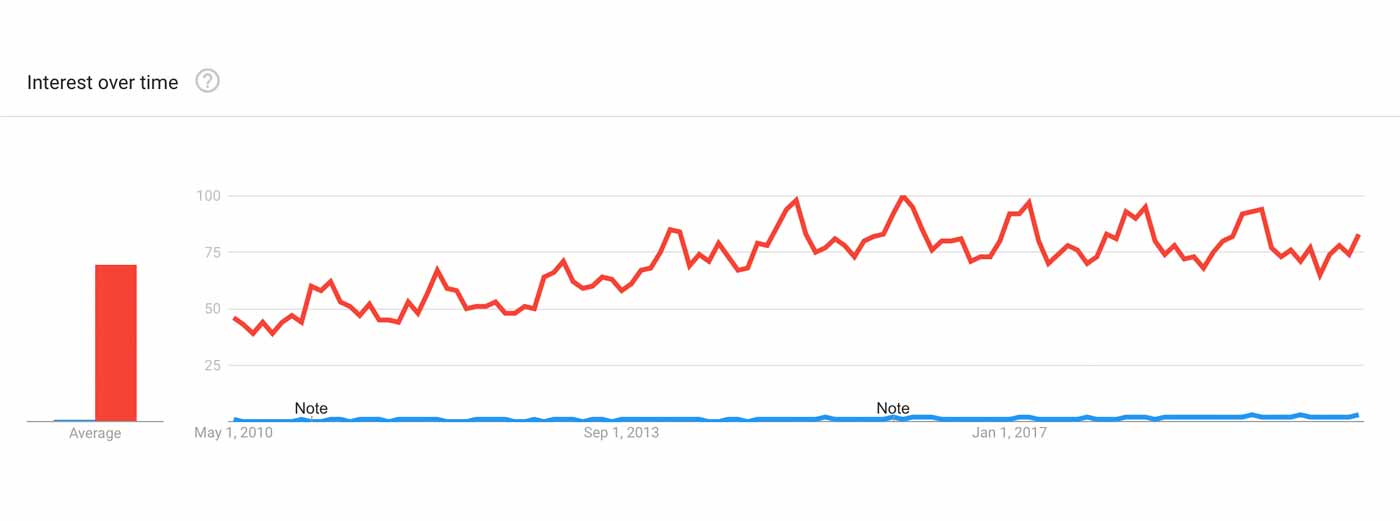
But even with powerbuilding rising in popularity, people are vastly more interested in powerlifting. Powerlifting is currently 28 times more popular than powerbuilding. And keep in mind that bodybuilding is three times more popular than powerlifting.
Cardio, HIIT & LISS
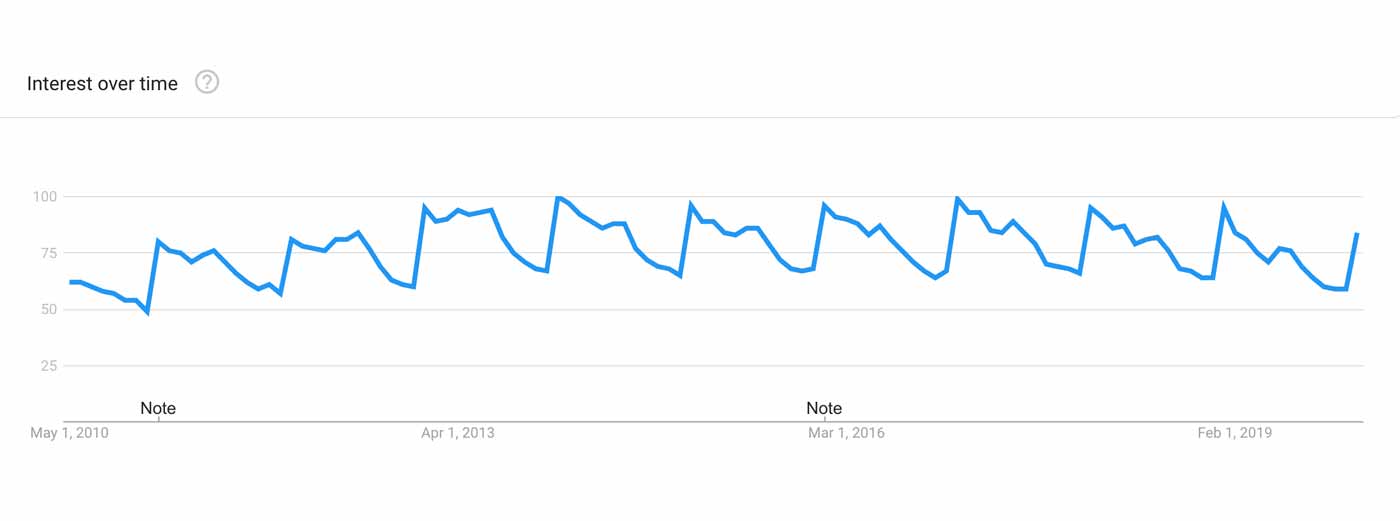
If we look at cardio terms, we see that cardio has a huge uptick every January as people start their New Year’s resolutions, and then its popularity gradually fades until the next January comes around. Every type of exercise booms in January and collapses during November and December, but it’s especially exaggerated with cardio.
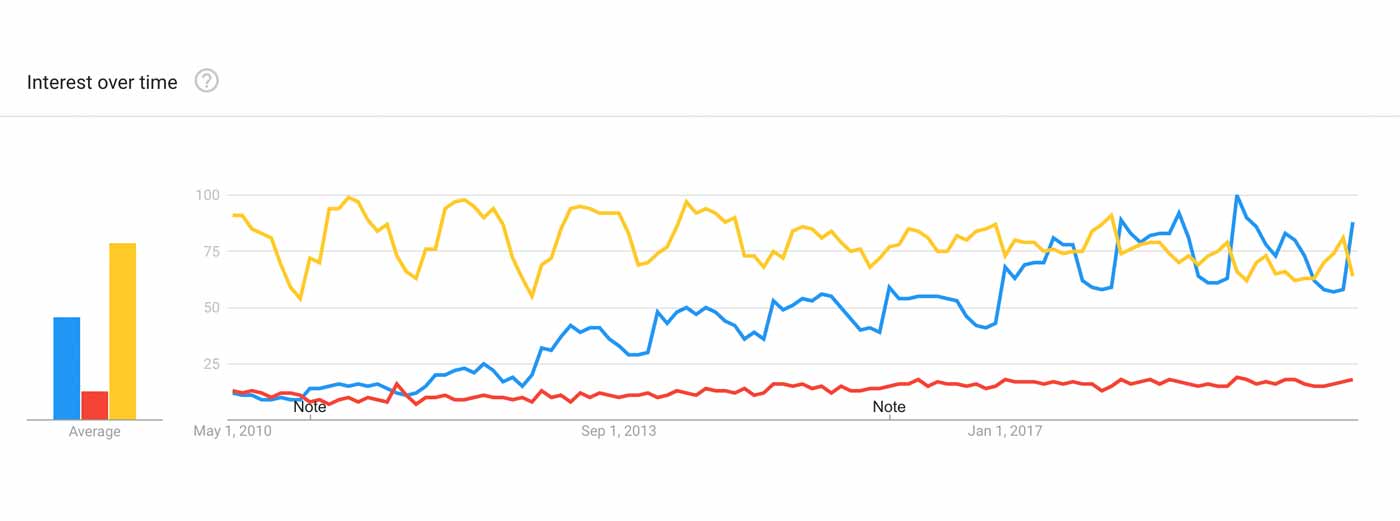
If we look at what types of cardio people do, we see that ten years ago, both high-intensity interval training (HIIT) and low-intensity interval training (LISS) were equally popular. However, ever since then, HIIT has been rising in popularity. It’s now around 4x as popular as LISS.
However, since LISS is a relatively uncommon term these days, I thought I’d toss in a common form of low-intensity exercise: jogging. We see that jogging has been falling slightly in popularity and that in the past couple of years, HIIT has overtaken it.

Cardio in general is doing quite well, too. A few years ago, bodybuilding was the more popular form of exercise. Nowadays, cardio has just ever so slightly edged it out.
Home Gym
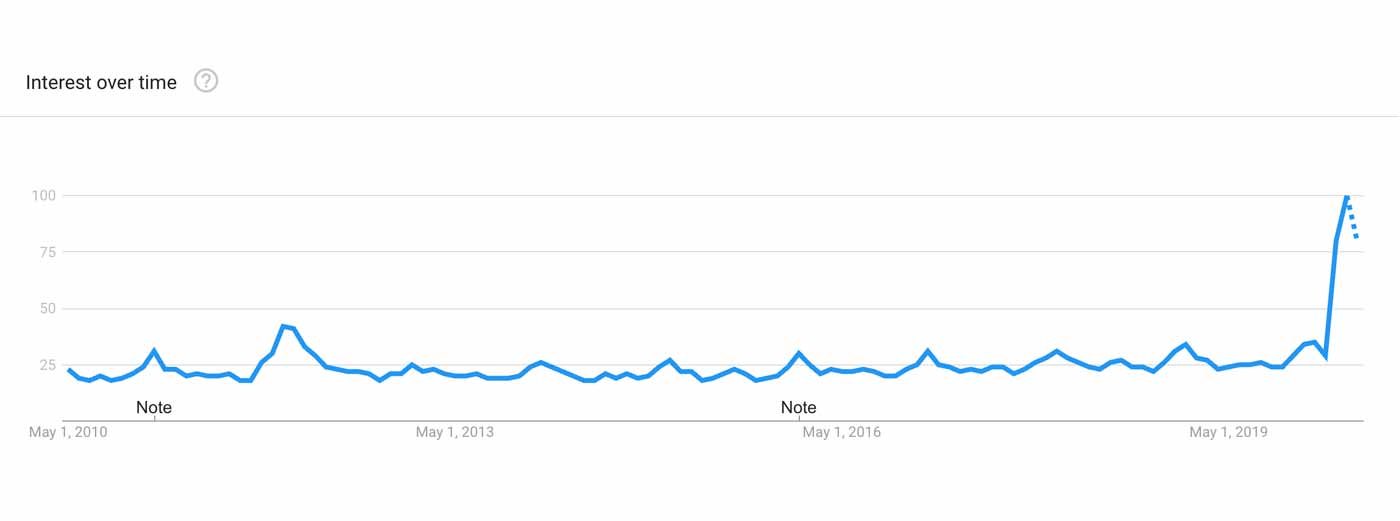
With gyms closing, it makes sense that everyone is searching about building a home gym. What I’m curious about, though, is that if everyone is building home gyms now, will they continue using them for years to come? Will home gym training remain more popular even when gyms reopen?
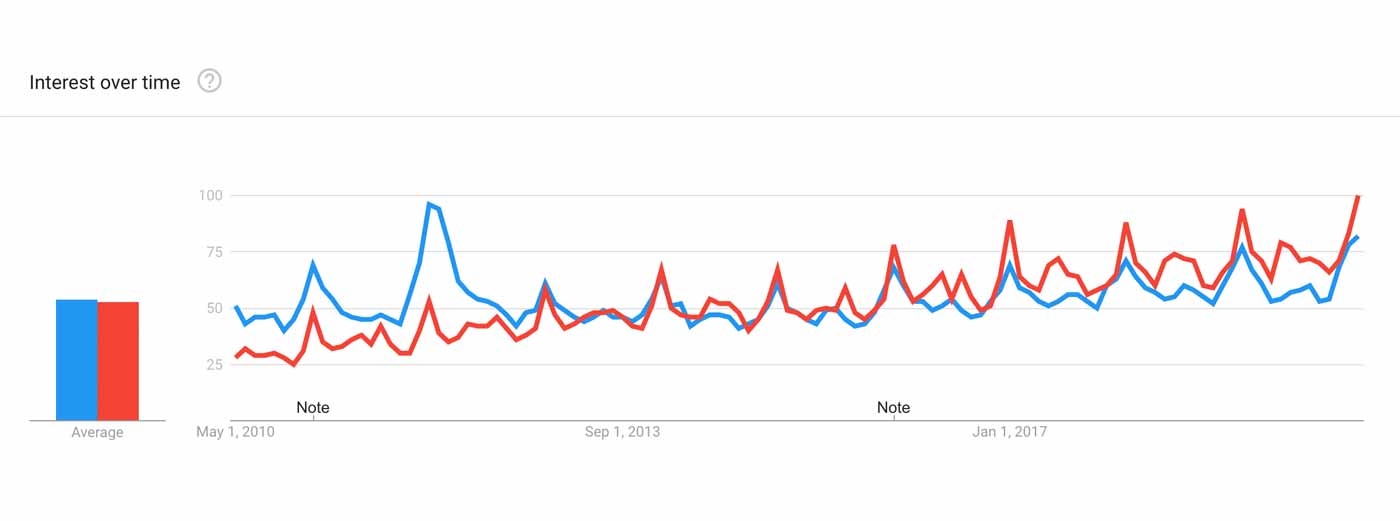
If we compare the popularity of gym memberships and home gyms, we see that interest in both has been gradually rising together. It seems like people are just more interested in lifting weights in general. Speaking from our own experience, with the 10,000 people we’ve coached through our muscle-building programs, a little over half of the men train at commercial gyms, whereas most of the women prefer to train at home.
Bodyweight Training
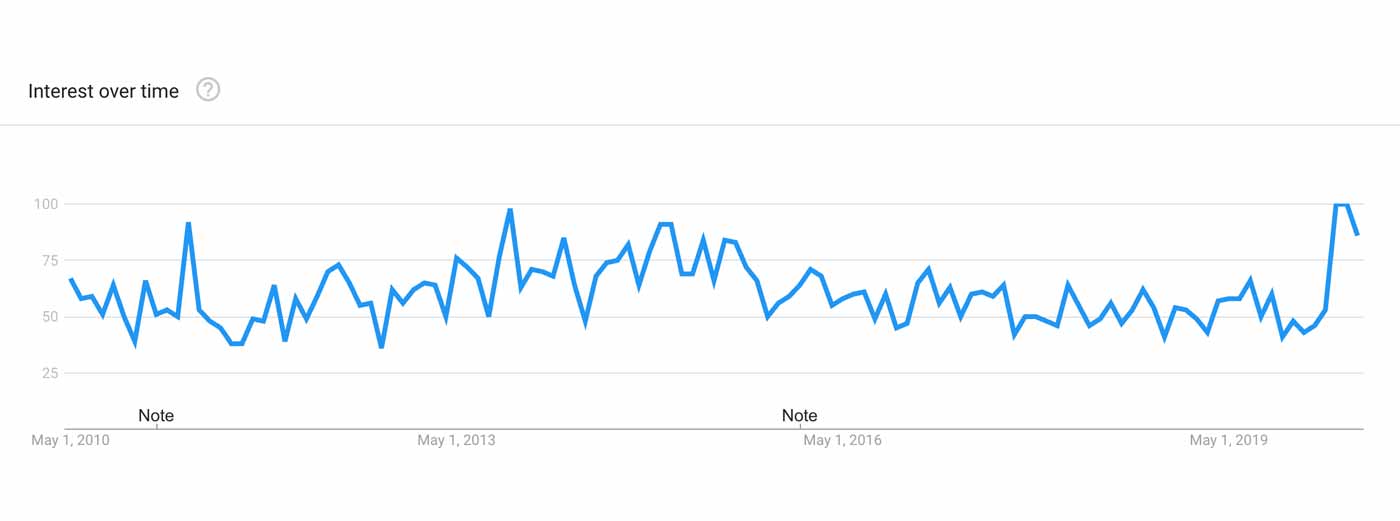
It looks like bodyweight training has hit an all-time high. It looks like before gyms starting closing, though, it was starting to fade in popularity. I wonder how this will play out in the coming years.
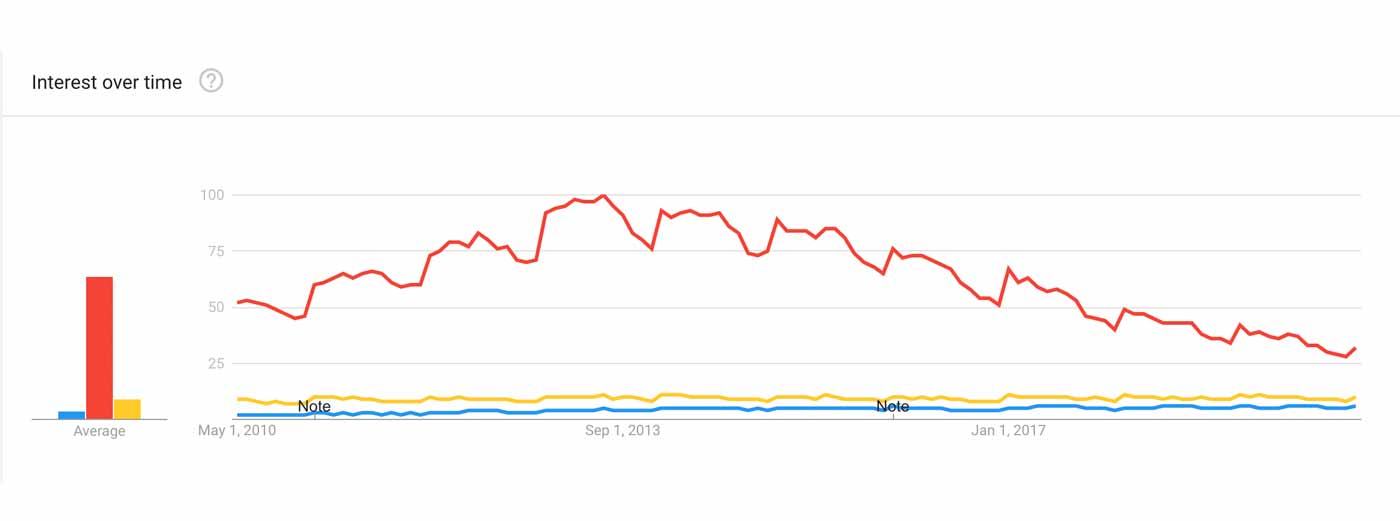
Of the bodyweight training terms, calisthenics is the most popular. And if we compare calisthenics against strength training and bodybuilding, we see that strength training is about twice popular, bodybuilding is about five times as popular.
Resistance Bands
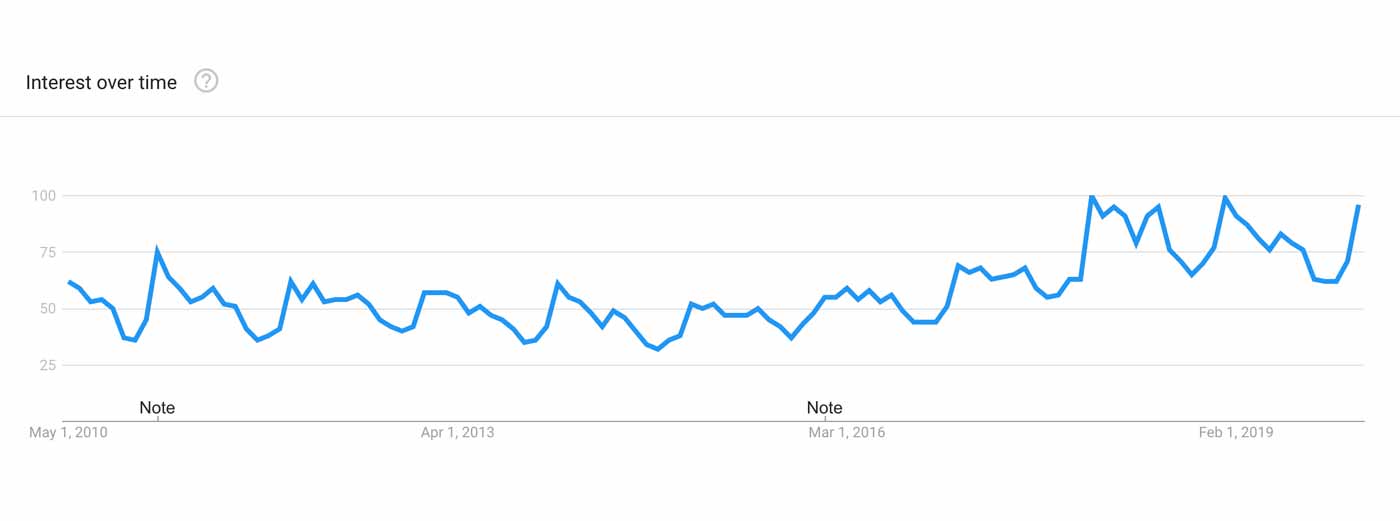
Resistance bands have been steadily climbing in popularity over the past ten years. If we compare them against the popularity of dumbbells and barbells, though, we see a bit of a different story.

The popularity of dumbbells and barbells has been skyrocketing compared to resistance bands.
Barbells vs Dumbbells
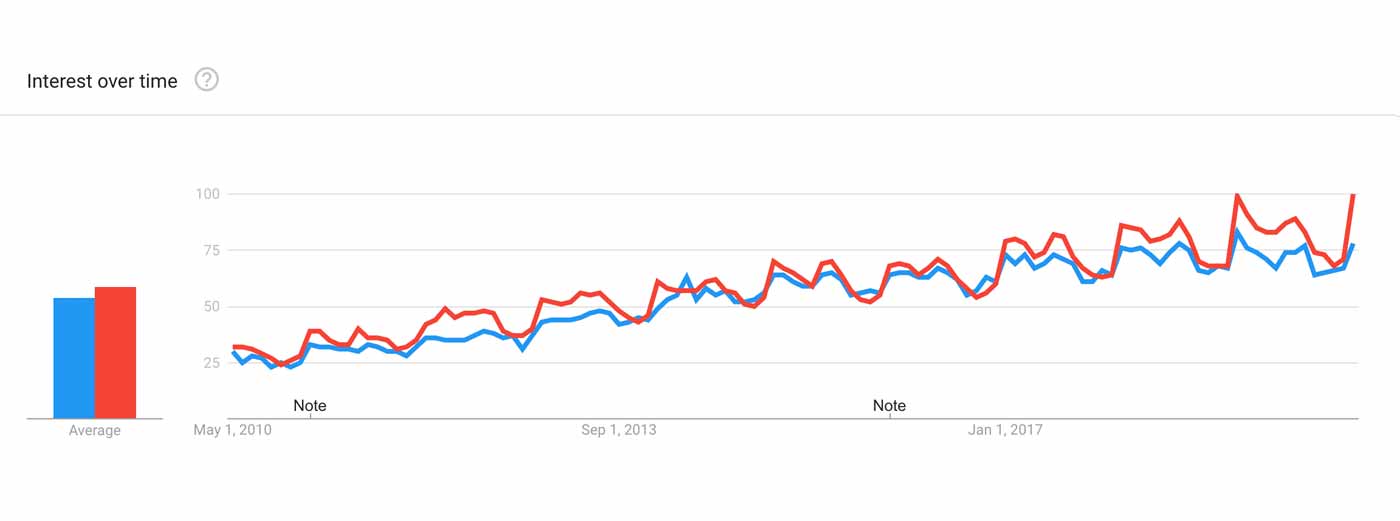
As mentioned above, barbells and dumbbells have been seeing a steep rise in popularity over the past ten years, and are both similarly popular to one another. That makes sense. A pair of adjustable dumbbells is an easy way to build a versatile home gym in a small apartment, whereas a barbell home gym tends to be best for people who have a spare room, basement, or garage.
Summary
It seems like people are interested in both cardio and resistance training, which is good. An overwhelming amount of research shows that both cardiovascular and resistance exercise are crucial for improving our health and longevity (study, study).
If we look at cardio, we see that jogging and other forms of low-intensity steady-state cardio (LISS) are losing popularity compared to high-intensity interval training (HIIT). That makes sense. HIIT workouts are far quicker and more efficient. What some people may not realize, though, is that HIIT is brutally painful and tiring when done properly, whereas some forms of LISS (such as brisk walking) can be quite easy and relaxing. Neither is better or worse, though, and a mix of both is probably best.
When it comes to resistance training, weight training and calisthenics are both popular. What surprised me was that far more people are interested in gaining muscle size than general strength, and that “bodybuilding” is by far the most popular form of weight training. Interestingly, though, despite the fact that bodybuilding is somewhat of a vague term, the more precise term of “hypertrophy training,” which is the type of training designed to stimulate muscle growth, hasn’t caught on (yet).

Finally, if we look at individual brands and programs, it seems like CrossFit is the most popular cardio program, Starting Strength is the most popular strength training program, and Athlean-X is the most popular bodybuilding program. What’s crazy, though, is what happens when we put the three of them together. CrossFit completely eclipses the other two programs.
This leaves me somewhat confused. If people are interested in improving their general health and cardiovascular fitness, I understand why CrossFit, HIIT, and jogging are popular. Everything lines up. But when we consider that just as many people are interested in gaining muscle size, why is is everyone doing CrossFit and Starting Strength? CrossFit is a fitness program and Starting Strength is a strength training program. These programs are good for what they’re designed for, but they’re not designed for building muscle, and they aren’t all that great at stimulating muscle growth.
Shane Duquette is the co-founder of Outlift, Bony to Beastly, and Bony to Bombshell. He's a certified conditioning coach with a degree in design from York University in Toronto, Canada. He's personally gained 70 pounds and has over a decade of experience helping over 10,000 skinny people bulk up.




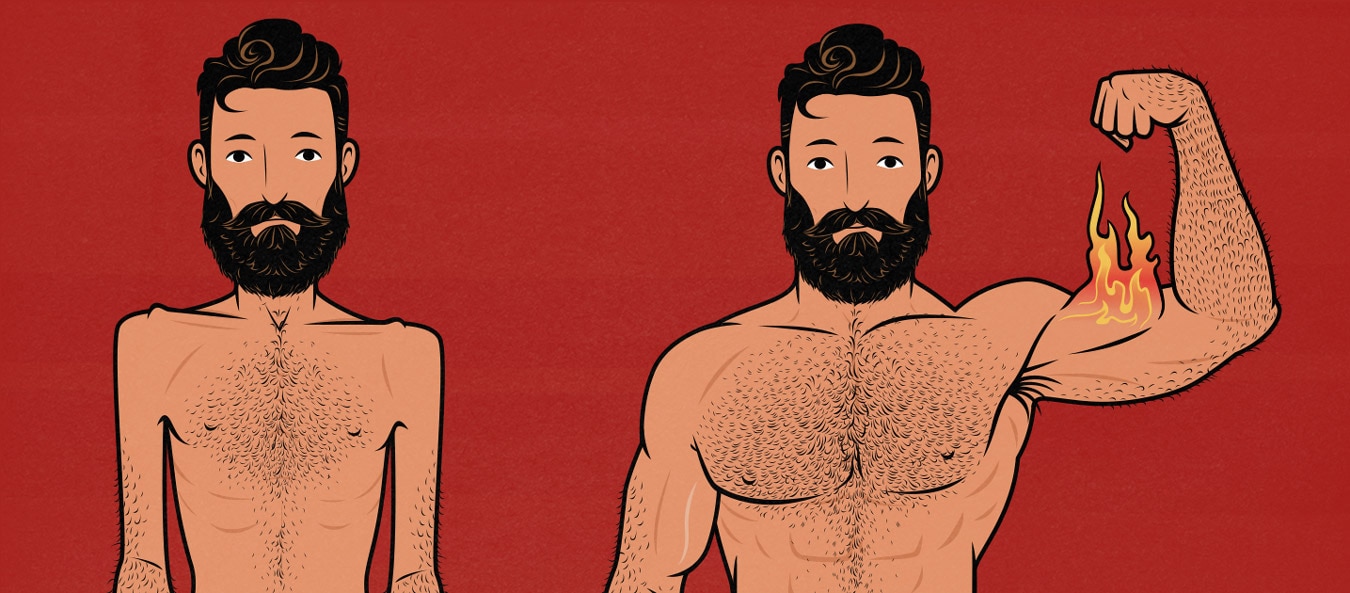
Great stuff, as always Shane!
Totally on board with preferring hypertrophy vs bodybuilder (as someone who’s far from a bodybuilder himself and isn’t a fan of the whole culture behind it) I’m surprised it’s so far ahead in search.
This whole series is fascinating, thanks for writing it, dude.
I’m glad to hear I’m not crazy for preferring the more technical term 🙂
My pleasure, man! I was interested in doing a bit of research just to see what might be fun to write about. And then I thought, huh, maybe other people would find it interesting too.
Interesting. Are the younger generations interested in hypertrophy ? Or just play with the smartphone? I
Ps. “Cardio is a fitness program and Starting Strength is a strength training program” you meant CrossFit.
Yikes! Yes. I’ll fix that now. Thank you, David 🙂
Regarding “Fitness Brands” — I really appreciate science/evidence-based content like Dr. Eric Helms & the 3DMJ team reference in their podcast. Side note: I also really like the Gravitus workout-tracking app that Helms once promoted (free version has more than enough functionality!).
Thank you, EJ. That really helps 🙂
I love Eric Helms’ content. His research, too. He recently published a study on calorie surpluses and bulking that was really cool. Him and Dr Brad Schoenfeld, I think, are putting out some of the best muscle-building research.
Hi, I would second the vote for the 3DMJ team. I have their training and nutrition guides and they are easy to read but also really detailed. I get Andy Morgan’s emails from rippedbody.com which are also good. For a bit more entertainment with your fitness I love Alan Thrall’s youtube channel as well as Athlean-X’s.
Yeah, the Muscle & Strength Pyramid eBooks are awesome!
I’m on Andy Morgan’s newsletter, too. Seems like a cool dude.
You know I always read all your stuff and love it!!! #fanboy. Have you heard of Ryan humiston? Buff guy getting really popular on YouTube and he’s hilarious and says a lot of “controversial” stuff (advocating for bro splits, overtraining, lifting to failure, etc.) I’d be interested to hear your take on him/I think if you wrote an article discussing and critiquing different popular fitness personalities and their training advice (humiston, kinobody, yo Elliot, Brad castleberry, Jeff cavaliere etc) I bet it’d go viral hahaha
Thank you, Ricky 😀
I had to google Ryan Humiston, but I recognize his face. I think I’ve seen him pop up in the recommended videos list on YouTube.
We’ve got an article reviewing Jeff Cavaliere’s / Athlean-X’s muscle-building program for skinny guys, Max/Size. It’s weird because it uses German Volume Training (among other things) but rebranded as his own style of training. The weird part is that German Volume Training is fairly well studied and is well-known as an ineffective way of training. Bizarre.
Reviewing Kinobody could be a ton of fun. I bought his program to take a look at it, see if it would make for a good review. And it’s actually pretty solid! It’s not quite how we make our muscle-building programs, and he’s one of those naturally hungry guys who builds his whole diet around appetite reduction, but the workout program is pretty good. I’m excited to write an article reviewing it.
I can check out the other names you mentioned, too. That’s really helpful 🙂
I love the content created by Jeremy Ethier. It is always based on scientific literature and is very well presented. He once used an illustration from your website. I also like Andrew John Morgan and Jeff Nippard because they also back their content by scientific evidence but Jeremy Ethier is my favorite.
In short, I only like to read content backed by scientific research.
Thank you, Ashhad!
Jeremy Ethier makes cool content, yeah. Especially his YouTube stuff. He’s killing it there 🙂
Jeff Nippard is awesome. His videos are great, and I think he’s got one of the best natural physiques in the world. That rare combination of world-class genetics, amazing training, and a killer work ethic. And his videos have a great aesthetic to them. Very cool content and brand.
Neat to see you mentioning Jeremy Ethier, Jeff Nippard, and presumably following us as well. All three of us are Canadian.
Who is Andrew John Morgan? Is that Andy Morgan from Ripped Body?
Yes, it is Andy Morgan.
I get a lot of fitness advice from Mike Matthews. Really like his straightforward and well researched style. I gained about 20 lbs of muscle following his Bigger Leaner Stronger plan.
That’s awesome, Jesse! Congratulations 😀
Okay, that’s good to know. Thank you. I can look deeper into his stuff 🙂
Hey Shane,
Will always be thankful to you and the B2B community for being my entry point into lifting and helping me to gain 30lbs of lean mass. You guys also introduced me to Eric Cressey of Cressey Sports Performance who has been an invaluable resource as I’ve embarked on a career as a personal trainer specializing in injury prevention and post-rehab training. Other trusted names in this field are Mike Reinold of Champion PT and Performance, and Dean Somerset (go Canada!)
It’s our pleasure, man! Thank you. And congratulations on those 30 pounds! That’s awesome 😀
(And yeah, Eric Cressey is amazing. A big part of our programming is based on what Marco learned from Cressey.)
Hey Shane,
I would be interested in your thoughts on advanced THT by Mark McManus (musclehack). Quite a decent workout. Also does a series of blast workouts, Arm Blast, Chest Blast and Shoulder Blast which he claims adds permanent size to your selected body part in 7-14 days. They are super intense and definitely taxing but also seems to work somewhat.
Be glad of your thoughts mate
Huh, I’ve never heard of him or those methods. I’ll take a look 🙂
I read a lot of T-Nation content (esp. Brad Schoenfeld and Christian Thibadeu). I think that site gets a bad rap sometimes, but a lot of their stuff is evidence-based and well written, so I like it.
Another place I love to read is the blog The Tight Tan Slacks of Dezso Ban. I take most of it with a grain of salt because most of the articles are old, but I love reading about the old school ways of gaining weight (esp. articles by John McAllum—he’s great!)
Hey Hank, yeah, I hear ya. T-Nation has a mixed reputation, and deservedly so. You get a wide variety of writers there. Sometimes that means dubious supplement ads and questionable advice. But oftentimes, like you said, you find articles by top researchers. They’ve got content by got Brad Schoenfeld, PhD, Brad Dieter, PhD, Greg Nuckols, MA, Eric Cressey, James Krieger, and John Berardi, PhD, who are some of the most credible experts out there. It seems like a lot of great fitness writers, such as Nate Green, got their start by publishing articles on T-Nation, too. The only catch is that you kinda already need to know which writers are good before browsing around.
I’d never heard of the Tight Tan Slacks of Dezso Ban. That might be the best blog name I’ve ever heard. Definitely going to check into that 🙂
Thank you!
Whadup, responding to the email.
My other most-consumed sources of information on weight training have over the years been Scott Herman, Athlean X, and Scooby1961. I only found Jeff Cavaliere a couple of years ago, but Scott and Scooby seem to go back eons on YT, and because they were among the first ones I found when I started, I’d often go back to them.
Then probably reading some stuff of T-Nation now and then, mostly when weight training was still new to me.
Yeah! Scott Herman is one of the foundational fitness YouTubers. And I love how he’s all about muscle, strength, and health. He’s a lifetime natural, discourages drug use, talks about realistic goals and physiques, calls out the bullshit whenever he can, and always seems to keep general health in mind. Whenever I see his videos, I get the feeling that he really wants what’s best for his audience. I’m a fan for sure.
I know less about Scooby, but I know he’s been around forever, too, and has built a loyal audience.
The cool thing about Scooby is that he just does it for fun, or so it seems. He doesn’t need to be an influencer or a brand or anything like that, which just makes him feel more trustworthy.
And on his website he shows pictures of his physique throughout his life, which is very cool because it shows how it’s possible to look like that consistently (it also shows how he’s been growing ever so slightly, showing that it’s a long-term thing).
So all of this makes him an outlier, and there’s probably a lot of people that wouldn’t find him beneficial because he doesn’t offer nearly as much content as you or someone like Scott Herman. But he can be good for at least looking up form on some exercises.
I think there are a few reasons Crossfit is so popular, but the biggest being it’s a social program. You sign up at a box (gym), they have class times, you show up at a class and do what you can. You get encouragement from more advanced members, but they welcome anyone at any fitness level. As you advance, it can offer competitive opportunities baked right into the culture. It includes cardio and some strength training, so it probably feels “well rounded” for the average person just wanting to “get back in shape”.
But I’d guess it’s the fact that you can go to it like a class with your friends that keeps many people involved. And it felt fresh and edgy for some, maybe, whose only experience with exercise was jogging and gym rats. There’s a lot of variety, so it probably stays interesting. And again. It’s a directed class, so you don’t have to think about any of it. You just show up and do it.
Caveat: I’ve never done Crossfit. This is just what I’ve gathered via osmosis.
I think you’re right, and I think that’s what I tend to forget. It’s not like people play pick-up games of basketball because it’s an idea form of cardio. No, they play because it’s a fun way to exercise and be healthy, be social, make friends, hang out. And CrossFit is like the lifting version of that. It’s a fun form of exercise, and then it comes with all of those other social and lifestyle benefits.
Your other point is a good one, too. You just show up and you’re guided through it.
And not being very social myself, that’s why I stay far AWAY from CrossFit (and basketball, and pretty much any kind of social activity you can think of outside of online gaming). Hahaha!
Ahaha me too! Which explains my confusion about CrossFit 😛
( Here from the email)
Aside from B2B, my go to guy for everything bodybuilding is Jay Ferruggia. His programs are simple and focused on getting the maximum results in as little time as possible. No flashy or trendy exercises thrown in for fluff in his programs, only the most effective and proven exercises.
He is also intensely focused on injury prevention and prioritizing form over all else. I started seeing my best results when I began focusing on working the target muscle as hard as possible with each and every rep as opposed to just trying to lift more weight than I did last week.
Hey Shane, interesting article!
I spent some time looking at google trends and I found out that the term “exercise” has been steadily gaining popularity since 2013 (significant uptick since the coronavirus lockdown this year too). This might be related to the decline in people looking up “bodybuilding”.
I think people are becoming less interested in bodybuilding culture specifically for some reason but are still trying to improve the way they look.
Hey Cerebral, that’s a really neat insight. I could see that being the case, for sure. It seems like the word “bodybuilding” carries a lot of baggage that people aren’t interested in. And to be honest, I feel that way, too. I lift weights, but I wouldn’t say that I’m a “bodybuilder” or that I do “bodybuilding.” But I’d definitely say that I exercise.